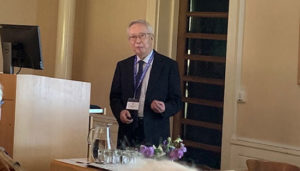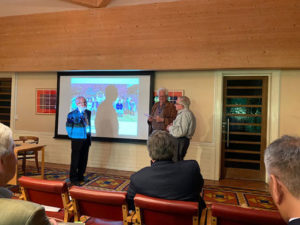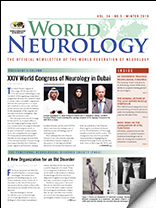By Martin Krenn and Wolfgang Grisold
The Oxford muscle symposium is an annual meeting of muscle specialists under the leadership of David Hilton Jones and Monika Hofer. This year’s meeting took place July 12-13 in Worcester College in Oxford, United Kingdom.

Prof. Nonaka giving the Meryon lecture at the Oxford muscle symposium.
It is a unique meeting, based on lectures and case presentations in muscle disease (myology). It has a rich history, dating back 44 years. Over the years, the meeting has witnessed the change of techniques and methods and the remarkable switch from histology and morphology toward molecular medicine and genetics. The cases presented are well researched and a highly qualified audience discusses the cases.
One special aspect is the Meryon lecture, which is organized to commemorate Edvard Meryon, by the Meryon Society. Meryon was a contemporary of Duchenne, and the naming of the disease is still controversial for the Meryon society1.
This year´s lecture was held by Prof. Ikuya Nonaka from Japan. It is a rare occasion to be privileged to listen to a researcher who has given the name to a rare disease2 Prof. Nonaka, from the National Center of Neurology and Psychiatry in Tokyo, Japan, gave his special lecture, titled “Special Aspects of Neuromuscular Diseases in Japan.”
In his lecture, Prof. Nonaka described neuromuscular diseases in Japan and the great discoveries of Prof. Myoshi, for whom he worked at the time. He also illustrated the history of Japanese neuromuscular departments that catered to neuromuscular patients, often dependent on ventilation. This has a long tradition in Japan and dates back to poliomyelitis epidemics. In this context, Prof. Nonaka told the story of one of his Duchenne patients, who despite his disorder was able to study law and attend university and worked as a lawyer.

Three giants of myology, discussing after Prof. Nonaka’s lecture. (From left to right) Prof. Nonaka, Prof. Hans Hilmar Goebel and Prof. Victor Dubowitz.
In 1981, Nonaka first described a subtype of distal myopathy, which was subsequently named after him (Nonaka Myopathy) and is now more commonly referred to as hereditary Inclusion Body Myopathy (hIBM) due to its hereditary (autosomal recessive) nature and its histological overlaps with classical inclusion body myositis. Later on, in the era of molecular genetics, the disorder was more precisely characterized and found to be caused by mutations in the gene GNE. While being considered as an ultra-rare (orphan) disease, the condition is also encountered outside Japan, most commonly in the United Kingdom, Bulgaria, India, and the Middle East.
From a clinical standpoint, the hallmarks of the disease remained widely unchanged since its first description by Nonaka almost 40 years ago. Neuromuscular symptoms usually start in early adulthood (third decade of life) with weakness and atrophy in distal limb muscles characteristically sparing the quadriceps. In spite of its slowly progressing natural course, it is a debilitating neuromuscular disorder, and most patients become wheelchair users 10 to 15 years after symptom onset. Although there is no approved treatment so far, modern advances in translational research give rise to the hope that targeted therapies may eventually also become available for GNE myopathy3.
Prof. Nonaka was able to give an overview not only on the detection of a rare neuromuscular disease, with tools of classical myology, which is now almost superseded by genetic studies, he also demonstrated his devotion to myology and above all to patients. •
Martin Krenn is in the department of neurology at the University Clinic of Vienna in Austria. Wolfgang Grisold is Secretary General of the WFN and works at the Ludwig Boltzmann Institute for Experimental und Clinical Traumatology.
References:
- Emery AE, Emery ML. Edward Meryon (1809-1880) and muscular dystrophy. J Med Genet. 1993 Jun; 30(6): 506–511.
- Nonaka, I., Sunohara, N., Ishiura, S., Satoyoshi, E. Familial distal myopathy with rimmed vacuole and lamellar (myeloid) body formation. J. Neurol. Sci. 51: 141-155.
- Pogoryelova O, González Coraspe JA, Nikolenko N, Lochmüller H, Roos A. GNE myopathy: from clinics and genetics to pathology and research strategies. Orphanet J Rare Dis. 2018 May 2;13(1):70
